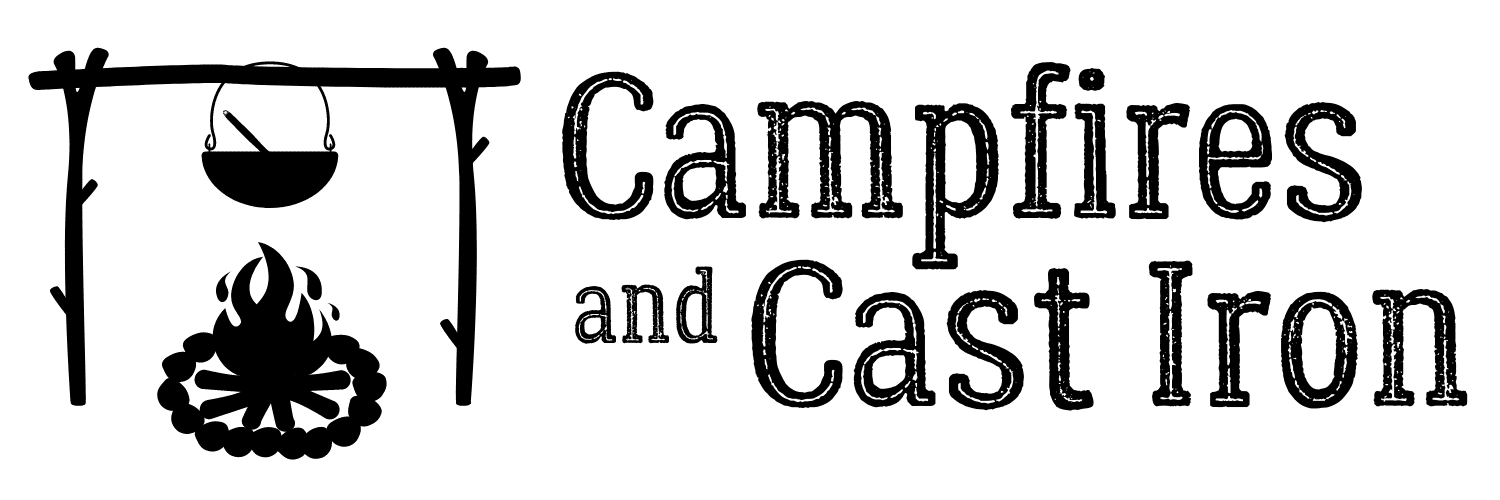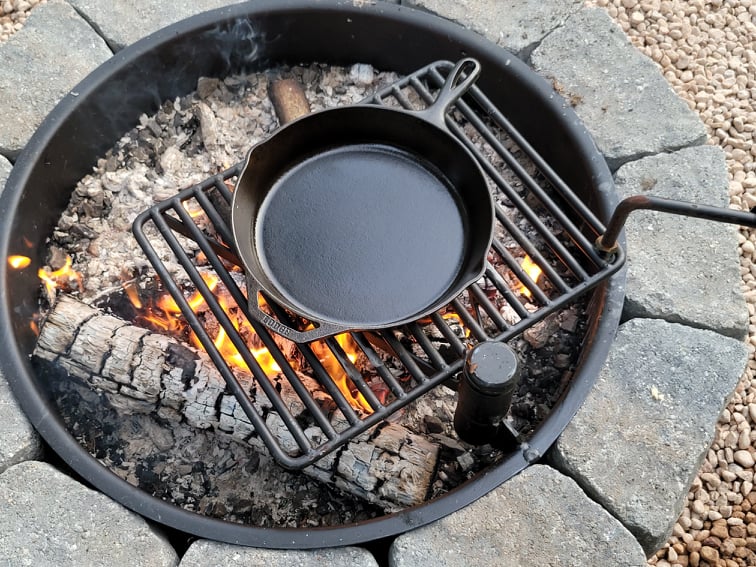If you’re like many campers, you enjoy cooking outdoors with a good cast iron skillet, dutch oven, or griddle. After all, there’s just something amazing about the way food tastes when it’s cooked outside. But how do you clean and sanitize your cast iron cookware while camping? It’s easier than you think!
How to clean cast iron cookware while camping in 5 steps:
- Remove remaining food and wipe out grease with a paper towel.
- Scrub the pan with water and a nylon brush. Rinse clean.
- Thoroughly dry the pan by heating it over a fire or camp stove for 1-2 minutes.
- Wipe a very thin layer of cooking oil onto the pan with a paper towel.
- Heat the pan over a fire or camp stove to re-season, then let it cool.
The steps above are simple and effective and have served me well for years. Now, let’s take a more detailed look at how to perform each of these steps to make sure your cast iron cookware is clean and safe to use while camping.
1. Remove Remaining Food And Grease
When it’s time to clean your cast iron skillet or dutch oven, you’ll want to first make sure it’s cool enough to handle safely. Letting the pan cool completely can make stuck-on food harder to remove, so a warm pan is fine, as long as it isn’t too hot to touch with bare hands.
Next, you’ll want to remove any leftover food scraps, sauce, and grease from the pan. Scrape out larger pieces of residual food with a spoon or spatula. Wipe liquids and grease out of the pan with paper towels. These can be disposed of in the trash or by sealing them in a plastic bag and taking them to an appropriate trash disposal site when you leave camp.
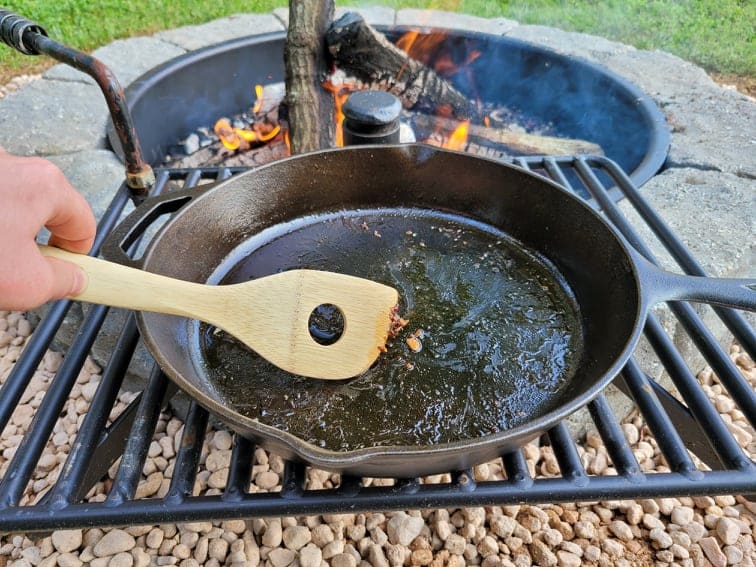
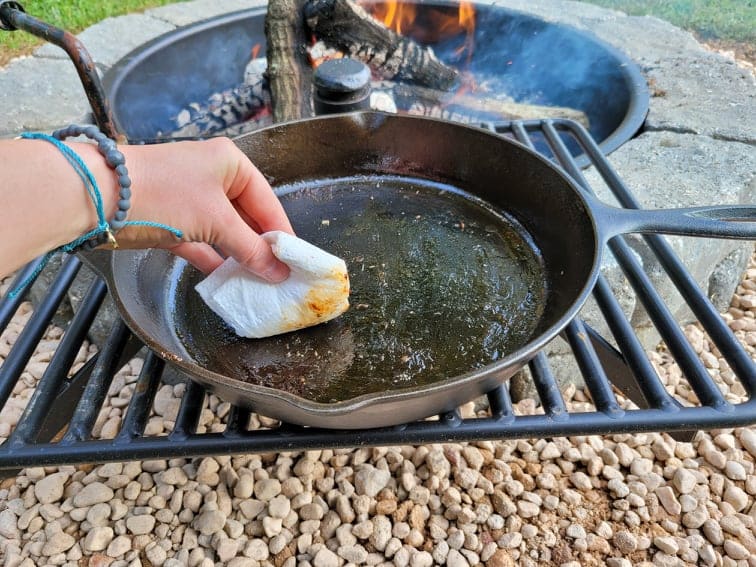
If you’re camping in an area where bears, raccoons, or other wildlife may be an issue, you’ll want to avoid burning food scraps and greasy paper towels in the fire. This will attract animals to your campsite and they may root through the ashes looking for food.
In addition to being harmful to animals and the environment, the lightweight embers from burning paper products can travel quickly and cause accidental campground and forest fires similar to the scenario described in this article by RVlife.com. To be safe and considerate, dispose of food scraps and paper products appropriately in the trash.
2. Scrub And Rinse
Once leftover food and grease have been removed from the pan, you’ll want to wash away any remaining food residue. Start by pouring water into the pan, then gently scrub it with a nylon scrubbing brush, plastic scraper, sponge, or a chain mail scrubber made specifically for cleaning cast iron. Avoid steel wool or metal scrub brushes, as they are too abrasive and can damage or remove the cast iron’s seasoning layer.
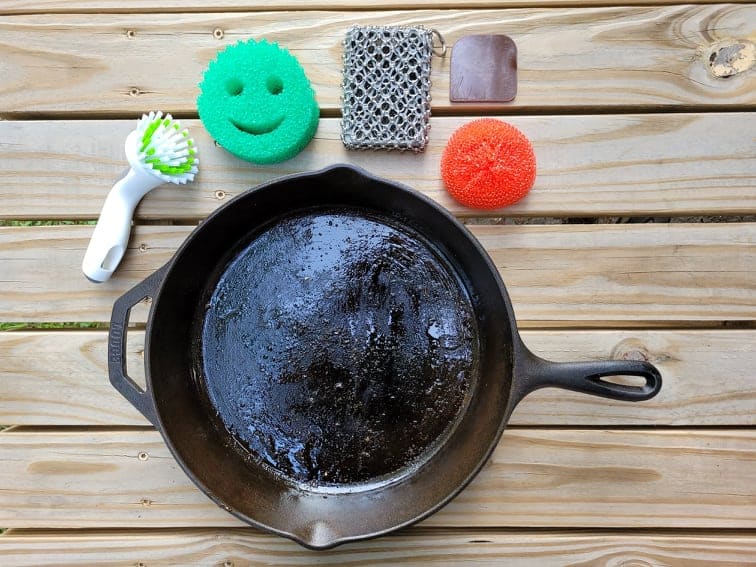

After you’ve given your pan a good scrub, rinse it with water. Repeat this process, if necessary, until the pan is clean. It’s also important to note that you don’t ever want to pour cold water on hot cast iron, as it can cause the pan to crack. Always wait until the pan is cool enough to handle.
Should I Use Soap To Kill Bacteria?
Many people are hesitant to use cast iron cookware due to the myth that you can’t use soap to clean and disinfect it. So, is this true, or not? This answer is quite divisive among cast iron users. Honestly, you could make a case either way. Let’s take a look at 1) Why it’s okay to use soap to clean your pan, and 2) Why it isn’t really necessary.
Is It Okay To Clean Cast Iron With Soap?
The truth is, yes, you can use soap when washing your skillet. Several years ago, when dish soap was lye-based, it was too harsh to be used on cast iron and would destroy the seasoning layer.
Today’s modern dish soaps are much gentler and are safe to use in small amounts on cast iron cookware without removing the seasoning. Sure, it may dry out the cooking surface of your pan more than if you only used water, but you’ll be doing a quick re-season of your pan with oil in the upcoming steps anyway. So, if you choose to use a little bit of soap, that’s perfectly fine. Just re-season, and you’ll be good to go! Still not sure about the soap? Check out what the pros at Lodge Cast Iron have to say.
Why Using Soap To Clean Cast Iron Isn’t Necessary
You’re also completely justified if you choose not to use soap on your cast iron. In fact, this is the more popular opinion and it’s been done this way for decades. Not only does avoiding soap help preserve the seasoning layer, but it also makes cleaning your cast iron while camping so much easier.
Here’s why using soap to disinfect cast iron is not necessary: In the process of cleaning your cookware, you’ll be heating it once to dry it, then again at a high temperature (well over 350 degrees) to re-season it. Exposure to high heat for several minutes will be more than enough to kill any bacteria on the pan.
How To Remove Stuck-On Food
If you find yourself struggling to get stuck or burned-on food off of your cast iron cookware and scrubbing with a brush isn’t cutting it, here are some other methods that should do the trick:
Boiling Water Method
Stubborn, stuck-on food can easily be removed from cast iron by boiling water in the pan. Just fill the pan with water to a level above the food residue and heat it to boiling over the fire or camp stove. Let it boil for a minute or two, then remove it from the heat. Let it cool for another couple of minutes, then carefully use a scrub brush or chain mail scrubber to clean the pan. Wearing heat-resistant gloves is a good idea to prevent accidentally burning your hands with hot water.
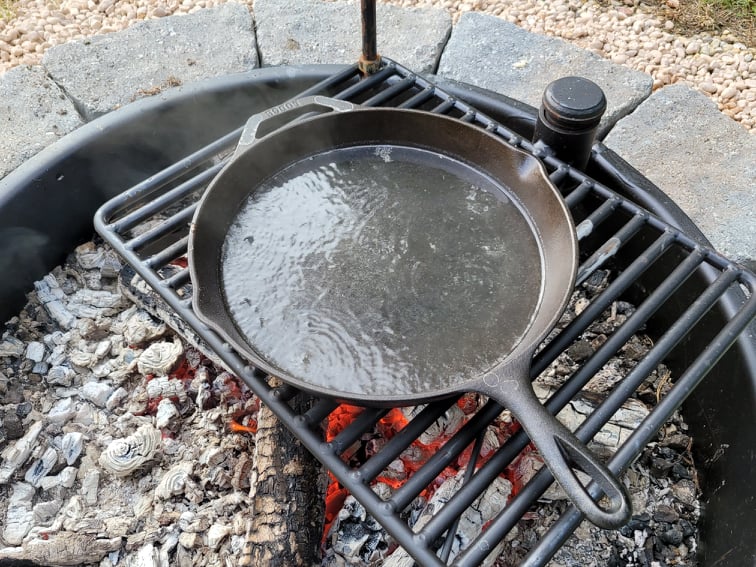
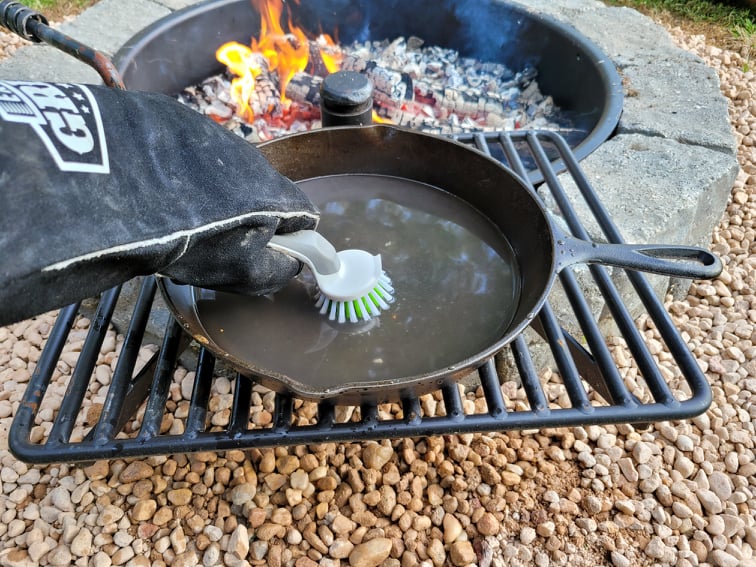
Salt Scrub Method
Another easy way to clean stubborn bits of food from cast iron pans is with a salt scrub. Pour about a half-cup of coarse grain salt into the pan while it is still warm. With paper towels or a folded washcloth, scour the pan until food residue is removed. Then, wipe the salt out and rinse the pan well, making sure not to leave any salt grains behind.
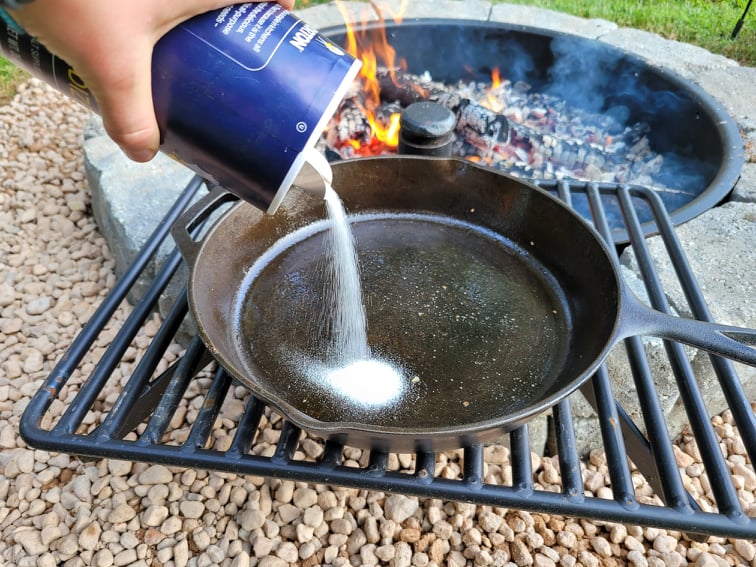
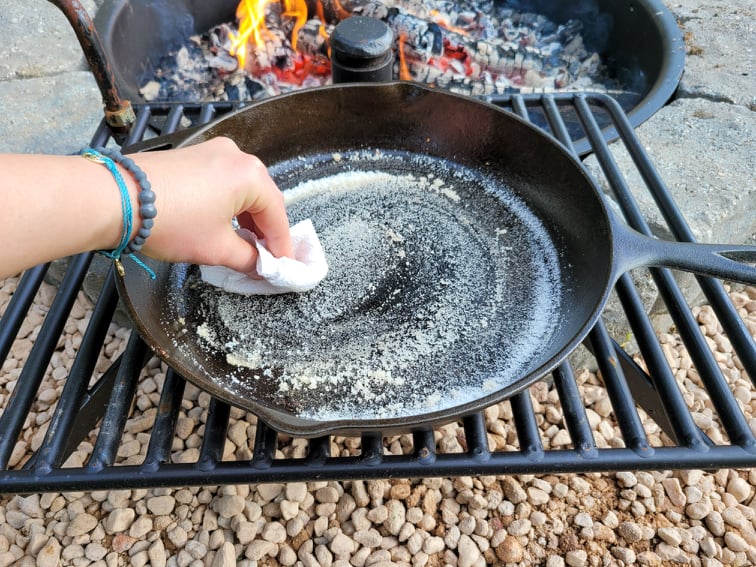
3. Thoroughly Dry The Pan
Once your cast iron skillet, dutch oven, or griddle is clean, it’s time to dry it. First, use a towel or paper towels to dry any visible water off of the pan. Next, heat the pan on medium-low heat over the campfire or on a camp stove for 1-2 minutes to make sure it is completely dry. Although it may look like your cookware is dry enough after using the towel and you may be tempted to skip this step, don’t! Because cast iron is a porous material, moisture can still remain in the iron and cause it to rust rather quickly. Always make sure your pan is completely dry by heating it.
In addition to ensuring the pan is dry, heating your cast iron like this will also kill bacteria. The process of heating the pan once when drying it and then again at a high temperature after applying the protective layer of oil (see steps below) will be more than sufficient to kill bacteria.

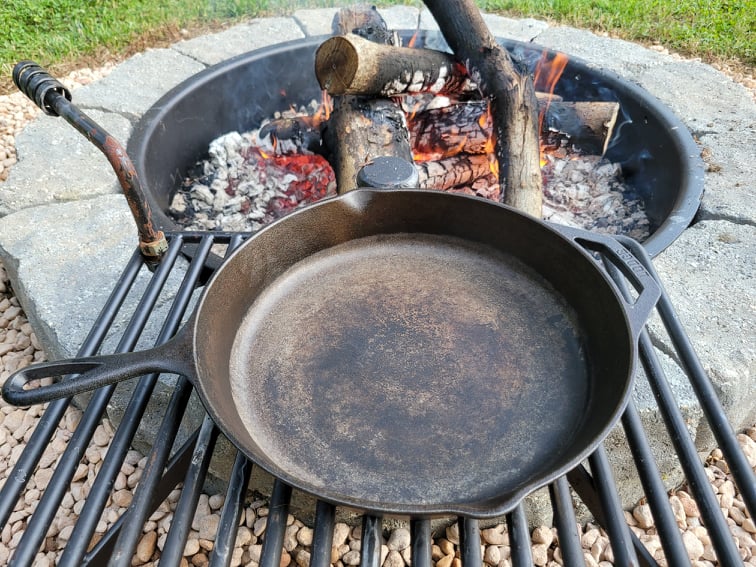
4. Apply A Thin Layer Of Oil
After washing and drying your cast iron pan, it’s important to protect it with a very light coat of oil. Not only will this keep the pan from rusting, but it will also protect the seasoning and make it ready to use for next time. To do this, pour about a teaspoon of oil (grapeseed, canola, or vegetable oil work best) into the pan and spread it very, very thinly over all of the inside surfaces with a folded paper towel.
You may need more or less oil, depending on the size of your pan. But the most important thing here is to avoid using too much, as it can cause the pan to become sticky and streaked. After applying the layer of oil, take a dry paper towel and wipe away any excess to avoid this.
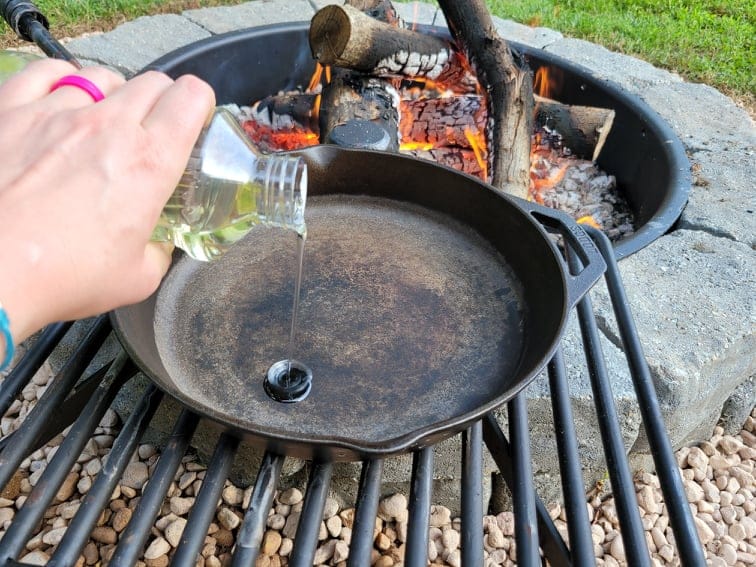
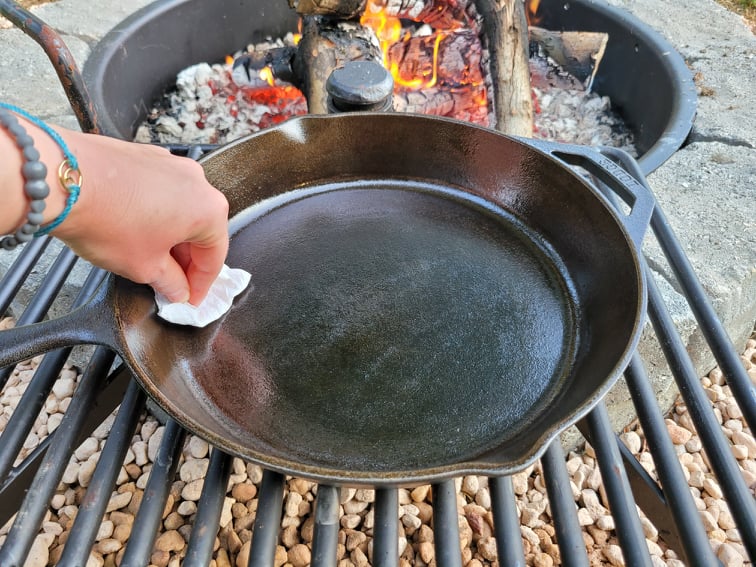
5. Heat To Re-Season
After applying a thin layer of oil, the last step is to heat the pan again over the fire or camp stove at a medium-high temperature for approximately 5 to 8 minutes. You’ll want to heat the cast iron until you see the oil smoking. This is what allows the oil to bind with the porous cast iron through a process called polymerization. Once the smoking has stopped, turn off the camp stove or remove the pan from the fire and let it cool.


And that’s it! Your trusty cast iron cookware is clean and ready to provide many more years of delicious campfire meals.
This post may contain affiliate links. This means if you click on a link and make a purchase, I will receive a small commission, at no cost to you, that makes it possible for me to keep the Campfires and Cast Iron site up and running. Please see our disclosure policy for details.
